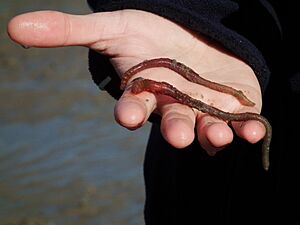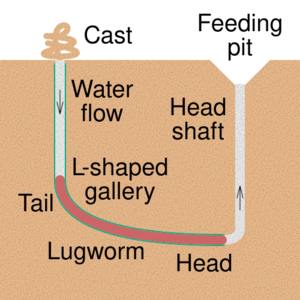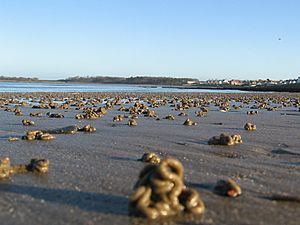Lugworm facts for kids
Quick facts for kids Lugworm |
|
|---|---|
 |
|
| Lugworm, Arenicola marina | |
| Scientific classification |
|
| Unrecognized taxon (fix): | Maldanomorpha |
| Family: | Arenicolidae |
| Genus: | Arenicola |
| Synonyms | |
|
|
Arenicola, often called sandworms, are a type of worm known as lugworms. They are marine worms that live in the sand, especially on beaches. You might not see the worms themselves, but you can often spot the signs of their homes!
Contents
What are Sandworms?
Sandworms belong to a group of worms called annelids. This means their bodies are made up of many small segments, like rings. Lugworms are a common type of sandworm found in sandy areas of the ocean, especially where the tide goes in and out.
Different Kinds of Sandworms
There are several different species, or types, of Arenicola sandworms. Each one has its own scientific name. Some of the recognized species include:
- Arenicola brasiliensis
- Arenicola cristata
- Arenicola defodiens
- Arenicola glasselli
- Arenicola loveni
- Arenicola marina (This is a very common type of lugworm.)
Life in a Burrow
A lugworm spends most of its life hidden away in a special U-shaped burrow in the sand. Imagine a tunnel shaped like the letter "U" under the ground.
How a Burrow is Built
The lugworm's burrow has two main parts:
- Head Shaft: One end of the "U" goes straight up to the surface. This is where the worm's head is usually located. At the surface, you might see a small, round dip in the sand, like a tiny saucer.
- Tail Shaft: The other end of the "U" also reaches the surface, usually about 2 to 3 inches (5 to 8 cm) away from the head shaft. This end is marked by a coiled pile of sand, which is the worm's waste.
The main part of the burrow, the "U" shape, is lined with sticky mucus. This helps to keep the sand from collapsing. The lugworm lies in its burrow, with its head near the bottom of the head shaft.
How Lugworms Eat and Breathe
The lugworm eats by swallowing sand from time to time. As it eats, the sand in the head shaft slowly drops down. This causes the small dip on the surface to sink a little bit.
To keep the sand loose and bring in fresh water, the lugworm creates a current of water through its burrow. It does this by making wave-like movements with its body. This current pulls water in through the head shaft and pushes water (and waste) out through the tail shaft. This process helps the worm breathe and brings in tiny bits of food from the water.
Reproduction
Lugworms usually stay in their burrows for weeks at a time. They don't often leave their sandy homes. However, there's a special time when many lugworms come together to reproduce.
The Breeding Event
For about two days in early October, a large number of lugworms release their eggs and sperm into the ocean water. This is where the eggs get fertilized.
The eggs are protected inside jelly-like masses. These masses are shaped like tongues, about 8 inches (20 cm) long, 3 inches (8 cm) wide, and 1 inch (2.5 cm) thick. Each jelly mass is attached to something at one end, like an anchor.
From Larva to Adult
Tiny larvae (baby worms) hatch from the eggs. They feed on the jelly until they grow bigger. Once they have about a dozen body segments and start to look more like their parents, they break out of the jelly.
These young worms then burrow into the sand, often higher up on the beach than where the adult worms live. As they grow older, they slowly move down the beach to deeper areas, where they will live out their adult lives.



